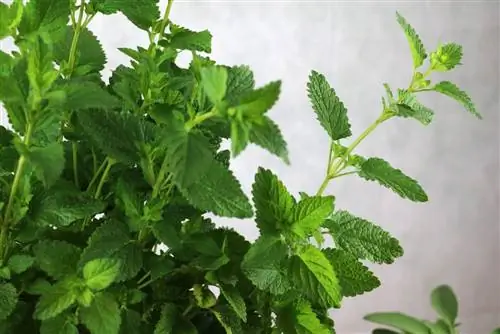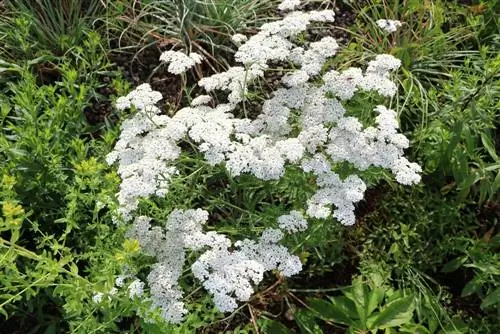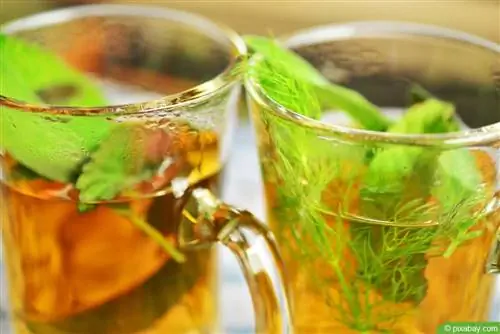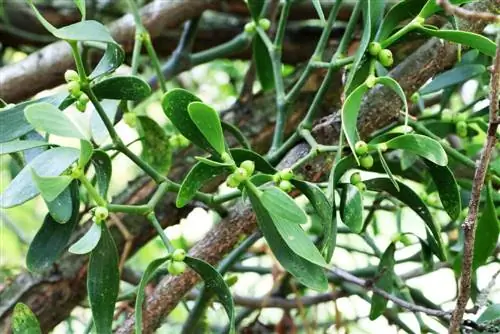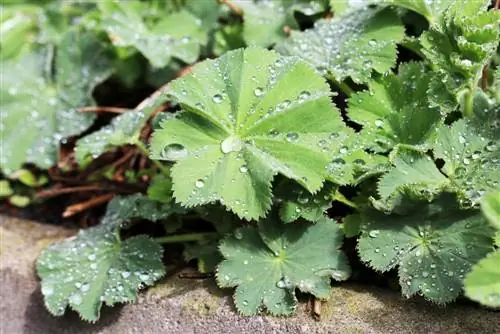- Author admin [email protected].
- Public 2023-12-17 03:39.
- Last modified 2025-01-24 12:45.
Whether in a pot on the balcony or in a corner of the garden: mint grows almost everywhere. The fresh, aromatic-smelling leaves make an excellent tea that also helps against all kinds of physical ailments. But be careful: Fresh peppermint tea can also have unwanted side effects, which is why you shouldn't always drink it. You can find out when homemade mint tea tastes good and how to prepare it in this informative article.
Positive effects of fresh mint tea
Peppermint (bot. Mentha x piperita) in particular has been known as a medicinal herb for centuries. The sharp-tasting leaves of this pretty garden plant contain high levels of the essential oil menthol, which has a stimulating and refreshing effect on the body. A tea made from fresh peppermint leaves is recommended, especially in the warm summer months, because the menthol it contains activates the cold receptors in the skin and thus refreshes the body. The drink has this effect even when you enjoy it hot - so it's no wonder that peppermint tea is so popular in Arab countries.
Tip:
The highest concentration of menthol is contained in the popular peppermint, which is why this type of mint is best suited for medicinal teas.
Mint tea instead of coffee
Can't do without your daily coffee, but want to reduce your consumption for he alth reasons? Then drink a cup of peppermint tea in the morning instead. This stimulates blood circulation, gets your circulation going even without caffeine and ensures that you start the day fresh and cheerful. The improved blood circulation also helps against tension headaches and relieves migraines.
Colds
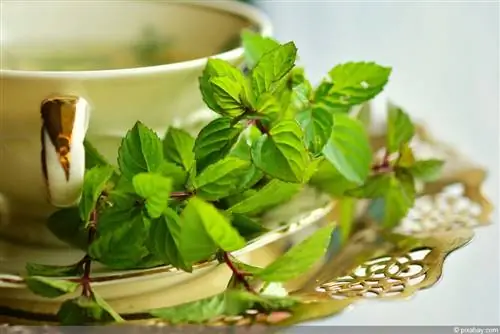
Peppermint tea is also one of the classic cold teas and helps to relieve typical cold symptoms and coughing:
- Menthol vapors stimulate blood circulation
- free the nose and upper respiratory tract from mucus
- have a decongestant effect
If you have a cold or hoarseness, it's best to drink hot mint tea, which you can also sweeten with a spoonful of real honey. Honey, in turn, soothes the throat and makes scratchy and sore throats more bearable. Enjoy the hot tea in small sips and breathe in deeply the rising menthol vapors.
Stomach problems
The relaxing effect of fresh peppermint also helps with stomach problems, for example as a result of
- a fatty, rich meal
- an upset stomach
- unusual food (for example on vacation)
- irritable bowel syndrome
Mint tea stimulates bile production, relieving the feeling of fullness and improving digestion after a heavy meal. The bile juice is essential for functioning fat digestion, which is why a cup of fresh tea supports the body in processing it. If you have an upset stomach or symptoms of irritable bowel syndrome, the drink has a relaxing effect and calms the nerves in the stomach and intestinal tract.
Tip:
Even those who want to lose weight benefit from fresh peppermint tea. The drink, enjoyed primarily before a meal or when cravings, calms the stomach and curbs the appetite. However, make sure not to stir sugar or honey into your tea for weight loss purposes and, if possible, not to drink more than four cups a day.
When to avoid mint tea
However, fresh peppermint tea not only has positive side effects, but also some undesirable side effects. If one or more of the following statements apply to you, you should avoid drinking this drink or only drink it in small quantities (for example a maximum of one to two cups a day).
- You are heavily pregnant or breastfeeding a baby.
- You have a sensitive stomach lining.
- You are prone to heartburn/reflux.
- You have gallstones.
The high menthol content of fresh peppermint has a weaning effect, i.e. it reduces the production of your breast milk. For this reason, you should only use peppermint tea if you actually want to stop breastfeeding. In this case, the drink can help you avoid possible engorgement.
Enjoyed in large quantities, pure peppermint tea can damage the stomach lining and promote the formation of stomach ulcers. Due to the relaxing effect of the essential oil, it is also possible that the stomach gate no longer closes properly and you then suffer from heartburn.
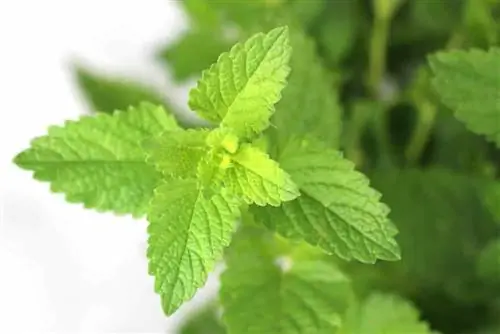
If you are also prone to gallstones, you should also avoid peppermint. The herb stimulates the formation of bile secretion, which in turn can result in severe abdominal cramps.
Tip:
Babies and small children should also not drink peppermint tea as their stomachs are still sensitive and they might spit afterwards.
Make your own mint tea
Peppermint tea can be bought in every supermarket. However, in order to benefit from the he althy effects of the drink, you should use leaves you have harvested from your own garden. If you don't have a garden, the pretty plant can easily be cultivated in a pot or bucket on the balcony or windowsill. But why is fresh mint preferable to store-bought tea? The reason is very simple: many purchased mint teas are contaminated with pesticides, as various consumer tests have shown in recent years. In addition, a tea made from fresh leaves tastes much more aromatic than one made from dried (and who knows how old) plant parts.
Which mints are suitable?
You should use the classic peppermint in your medicine cabinet, as only it has the he alth effects described. Mentha x piperita has the highest menthol content of all mints. If, on the other hand, you would like to drink mint tea but want to avoid the unpleasant side effects, various other types of mint are available. These contain less menthol, are therefore significantly milder and more suitable as a daily drink. These varieties are particularly suitable as tea mints:
- Fruit mints such as apple mint, lemon mint, pineapple mint, strawberry mint
- Moroccan mint or nana mint (bot. Mentha spicata 'Morocco')
- Spearmint or spearmint (bot. Mentha spicata)
The fruit mints in particular are very mild and also taste good to children. However, the slightly poisonous polei mint (bot. Mentha pulegium), which is also known as fleaweed and is easily confused with peppermint, is not suitable as a drink.
Dosage and preparation
For a fresh infusion, pluck between five and seven he althy leaves or the upper ends of the stems per liter of water. Place them in a jug and pour boiling hot water over them. Ideally, the water has a temperature of 95 degrees Celsius, so it should no longer bubble. Let the tea steep for about ten to 12 minutes with the lid closed. This is important because otherwise the volatile menthol disappears and the drink no longer tastes as aromatic. You can then sweeten the mint tea with sugar, brown sugar, rock sugar, stevia or honey as desired. A tablespoon of freshly squeezed lemon juice also tastes wonderfully refreshing in summer. Garnish cooled peppermint tea as iced tea with ice or frozen apple juice cubes and a few lemon slices.
Tip:
Don't just enjoy the drink straight, but mix the mint with lemon balm, blackberry or strawberry leaves, a pinch of cardamom, green or black tea, lemongrass or a little ginger.

